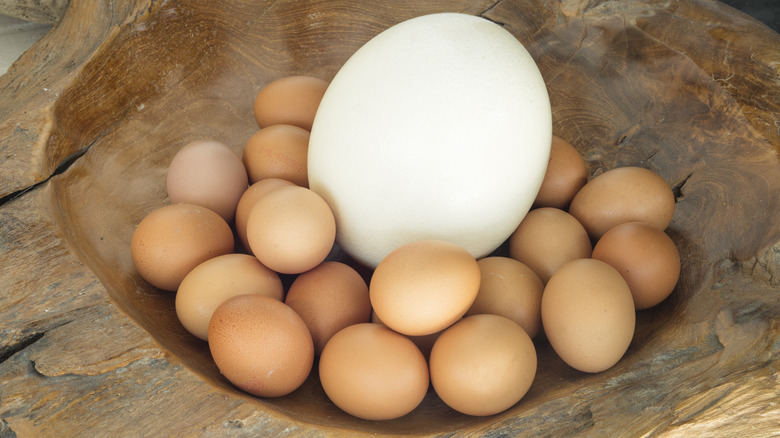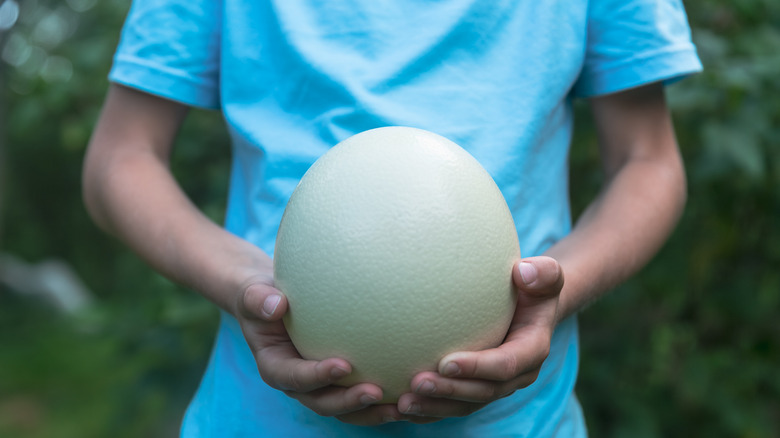Ostrich Vs. Chicken Eggs: Which Is More Nutritious?
Ostriches are enormous — they're the largest birds on Earth, after all — so it should come as no surprise that their eggs are big, too. But unless you've actually seen one, you may not realize just how big. The average ostrich egg, for instance, weighs upwards of three pounds and is about seven inches long. In comparison with the hen-laid eggs that are a staple of the American breakfast, it would take two dozen of them to equal a single ostrich egg.
Ostrich eggs don't just dwarf chicken eggs in size; however, they also outshine them in terms of nutritional value. Ostrich eggs are a fantastic source of protein — a whopping 47 grams in each egg, according to the Medical Health Authority — and in addition to boasting a better fat profile than chicken eggs (more healthy unsaturated fats, fewer saturated fats), they're also teeming with vitamins and minerals. The consumption of ostrich eggs, it turns out, promises a wide variety of health benefits, including a healthier heart (thanks in part to an abundance of omega-3 fatty acids, per Livestrong), stronger bones, and a more robust immune system.
Did we mention ostrich eggs may taste better than chicken eggs, too? They're definitely sweeter.
A nutritional comparison of ostrich and chicken eggs
Ostrich eggs are clearly nutritious, but it helps to compare their nutritional profiles with chicken eggs to provide appropriate context. Given the significant size differential between the two, however, it's necessary to evaluate them based on serving sizes of 100 grams. Both, by this measure, contain 154 calories per serving, but ostrich eggs have more protein (13.3 grams to 11), less fat (10.9 grams versus 12 for chicken eggs), and less sodium (142 to 155 milligrams), but slightly more carbs and cholesterol. Ostrich eggs also provide more essential minerals like iron and magnesium than chicken eggs but less vitamin A and E.
So adjusted for size, the nutritional profiles for ostrich and chicken eggs are not as dissimilar as a one-to-one comparison would suggest. Of course, the fact remains that adjusting for size is not so easy when it comes to cooking the respective eggs. An average ostrich egg, after all, has a serving size of 1400 grams. Chicken eggs, by contrast, are only about 70 grams. Thus, one cannot cook the ostrich equivalent of three (or five or 10) chicken eggs. Once you crack an ostrich egg — and good luck with that, as they also happen to have a shell that's ten times thicker, and requires vastly more breaking strength — you're cooking the equivalent of at least 20 chicken eggs (the caloric equivalent is closer to 24), with all of the supercharged nutritional value that entails.
Why ostrich eggs aren't more popular
Given their positive nutritional profile, you might wonder why more people aren't making ostrich egg omelets for breakfast. There are several reasons, actually, that these eggs aren't more widely consumed. One is the time it would take to cook them and the kitchen equipment you'd need to do so. An average skillet isn't big enough to handle these massive eggs, and it can take up to an hour and a half to hard boil one. Preparing an ostrich egg any way at all, in fact, is likely to take at least 45 minutes.
It's not just the time and effort that's the issue. There's also the problematic serving size. When a single three-pound egg provides enough calories to satisfy the recommended amount for an entire day, it's obvious these eggs are way too much for one person to consume. But if you're cooking scrambled egg for a half dozen or so of your closest friends or family members, one ostrich egg will feed everyone nicely.
Finding them is another issue, however, as ostrich eggs aren't normally sold in supermarkets. But if you're willing to search them out in boutique grocery stores or specialty markets — and willing to pay up to $40 for a single egg — they offer not only an interesting food experience but an incredibly nutritious one as well.



